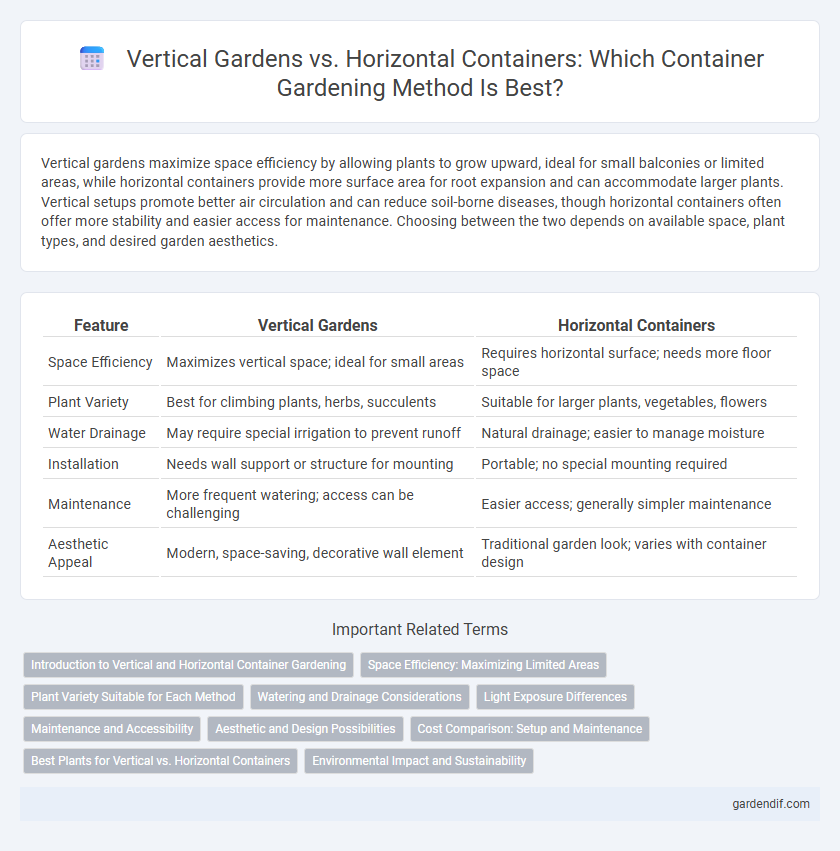
Vertical gardens vs horizontal containers Illustration
Vertical gardens maximize space efficiency by allowing plants to grow upward, ideal for small balconies or limited areas, while horizontal containers provide more surface area for root expansion and can accommodate larger plants. Vertical setups promote better air circulation and can reduce soil-borne diseases, though horizontal containers often offer more stability and easier access for maintenance. Choosing between the two depends on available space, plant types, and desired garden aesthetics.
Table of Comparison
| Feature | Vertical Gardens | Horizontal Containers |
|---|---|---|
| Space Efficiency | Maximizes vertical space; ideal for small areas | Requires horizontal surface; needs more floor space |
| Plant Variety | Best for climbing plants, herbs, succulents | Suitable for larger plants, vegetables, flowers |
| Water Drainage | May require special irrigation to prevent runoff | Natural drainage; easier to manage moisture |
| Installation | Needs wall support or structure for mounting | Portable; no special mounting required |
| Maintenance | More frequent watering; access can be challenging | Easier access; generally simpler maintenance |
| Aesthetic Appeal | Modern, space-saving, decorative wall element | Traditional garden look; varies with container design |
Introduction to Vertical and Horizontal Container Gardening
Vertical container gardening maximizes limited spaces by allowing plants to grow upward on structures like trellises or wall-mounted systems, enhancing airflow and light exposure. Horizontal container gardening utilizes traditional pots and raised beds, providing ample root space and easier access for maintenance and harvesting. Both methods cater to different spatial constraints and plant types, optimizing growth conditions in urban and small-scale environments.
Space Efficiency: Maximizing Limited Areas
Vertical gardens maximize limited areas by utilizing vertical space, allowing more plants to grow within a smaller footprint compared to horizontal containers. This approach increases planting density and is ideal for urban environments where floor space is scarce. Horizontal containers require more ground area and often limit the number of plants that can be cultivated efficiently.
Plant Variety Suitable for Each Method
Vertical gardens excel at supporting vining plants like cucumbers, tomatoes, and beans, which thrive when growing upward in confined spaces. Horizontal containers are more suitable for sprawling or root-heavy plants such as lettuce, carrots, and strawberries that require broader soil surface area for optimal growth. Selecting the appropriate container orientation maximizes plant health by aligning physical growth habits with space and structural support needs.
Watering and Drainage Considerations
Vertical gardens require careful watering strategies to ensure even moisture distribution across multiple layers, often benefiting from drip irrigation systems that minimize water runoff and evaporation. Horizontal containers typically offer more uniform drainage through bottom holes, preventing waterlogging and root rot by allowing excess water to escape efficiently. Selecting well-draining soil mixes and monitoring moisture levels is essential for both setups to maintain plant health and prevent overwatering.
Light Exposure Differences
Vertical gardens maximize light exposure by positioning plants along a vertical plane, allowing sunlight to reach each layer more evenly and reducing shading among plants. Horizontal containers, placed flat on the ground or surfaces, often experience uneven light distribution with lower layers receiving less sunlight due to shading from upper foliage. Optimizing light exposure in vertical gardens supports healthier plant growth and higher yields compared to the relatively limited light access in horizontal container setups.
Maintenance and Accessibility
Vertical gardens offer easier accessibility for maintenance tasks such as pruning, watering, and harvesting due to their upright structure, reducing strain on the gardener. Horizontal containers may require more bending and reaching, which can increase physical effort and time spent on upkeep. The vertical design also improves airflow and sunlight exposure, often minimizing pest issues and simplifying regular care.
Aesthetic and Design Possibilities
Vertical gardens maximize space by allowing plants to grow upward, creating striking green walls that serve as living art pieces in urban environments. Horizontal containers provide versatility in design with varied shapes, sizes, and arrangements, enabling gardeners to craft layered landscapes or focal points on patios and balconies. Combining both approaches enhances aesthetic appeal, offering dimensional contrast and dynamic visual interest in diverse settings.
Cost Comparison: Setup and Maintenance
Vertical gardens typically require higher initial investment due to specialized structures and irrigation systems, whereas horizontal containers involve lower setup costs with simpler materials. Maintenance expenses for vertical gardens can be elevated because of the need for regular pruning and potential repairs to support frameworks, while horizontal containers generally incur lower upkeep costs with easier access for plant care. Overall, horizontal containers offer a more budget-friendly option for both installation and ongoing maintenance in container gardening.
Best Plants for Vertical vs. Horizontal Containers
Vertical containers excel with climbing plants such as ivy, philodendrons, and string of pearls, thriving due to their support structures and vertical space utilization. Horizontal containers are ideal for sprawling, low-growing plants like succulents, herbs, and lettuce, benefiting from expansive surface area and stable root development. Selecting plants based on container orientation enhances growth efficiency, space management, and aesthetic appeal.
Environmental Impact and Sustainability
Vertical gardens maximize green space efficiency, reducing urban heat islands and improving air quality, while horizontal containers typically require more land and water resources. The vertical orientation enables efficient water usage through gravity-fed irrigation systems, minimizing runoff and conserving water compared to traditional horizontal setups. Sustainable urban greening favors vertical gardens for their ability to enhance biodiversity, lower carbon footprints, and support eco-friendly urban planning.
Vertical gardens vs horizontal containers Infographic

 gardendif.com
gardendif.com